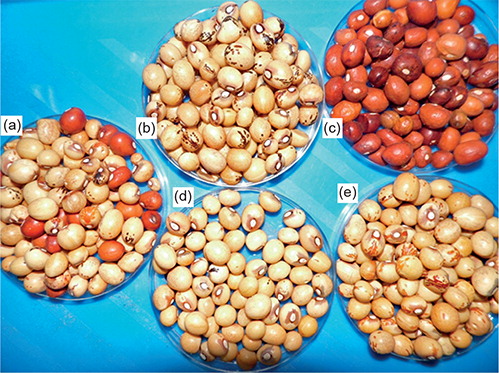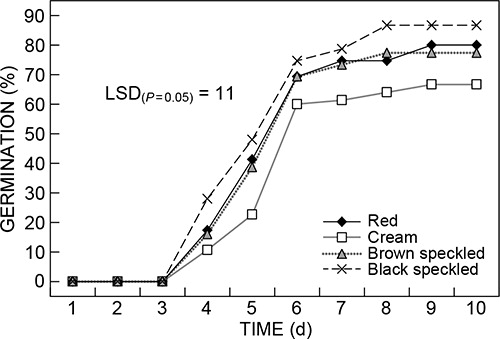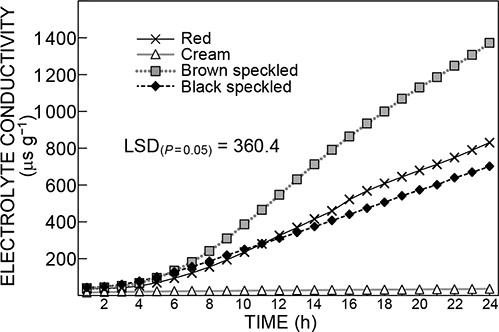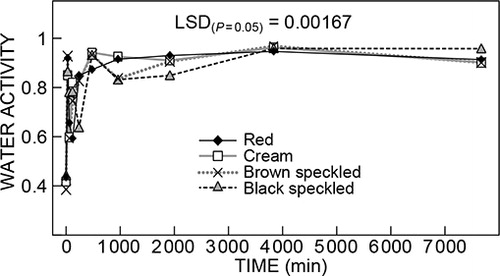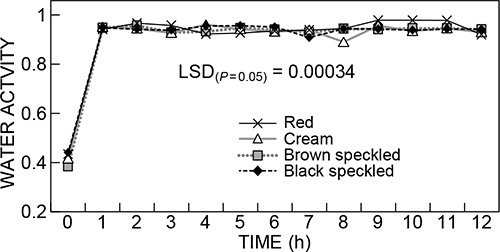Abstract
Bambara groundnut (Vigna subterranea L.) is an underutilised African legume that fits the same ecological niche as Arachis hypogea. It is still cultivated using landraces and little is known about their seed quality. The current study evaluated seed quality characteristics (viability and vigour) of a local landrace on the basis of seed coat and speckling colour (plain red, plain cream, black speckles and brown speckles). Standard germination and electrolyte conductivity (EC) tests were used to evaluate viability and vigour. Seed imbibition rate was evaluated using two imbibition methods (seed-testing water bath and seed soaking). For each method, seeds were weighed at intervals and their water activity determined. Electron microscopy was used to determine seed coat thickness. There were highly significant differences (P < 0.001) among landrace selections with respect to germination, EC as well as imbibition and water activity. Black-speckled landraces had the highest germination (87%) and the plain cream landrace selections had the lowest final germination (67%). Brown-speckled and plain cream seeds had the highest (1 400 µs g-1) and lowest EC (36 µs g-1), respectively. Imbibition rate and water activity showed much fluctuation. Electron microscopy revealed that brown-speckled seeds had the thickest (116 µm) and plain cream seeds had the thinnest (107.9 µm) seed coats. The study concluded that seed quality in bambara groundnut was associated with seed coat and speckling colour.
Introduction
Bambara groundnut (Vigna subterranea L.) is an underutilised grain legume, popular among women subsistence farmers in sub-Saharan Africa (Azam–Ali et al. Citation2001). Bambara groundnut is cultivated using landraces that are mainly genetically heterogeneous and retained from farmers’ previous harvest (Hillocks et al. Citation2011). Successful production of bambara groundnut is dependent upon availability of good-quality seed. To a seed scientist, good-quality seed would be the sum of many differing components, including genetic quality, physical purity, germination, vigour, uniformity in size and freedom from seed-borne diseases (McDonald and Copeland Citation1997; Basra Citation2005). To a farmer, good-quality seeds possess all the physical, physiological, pathological and genetic attributes that contribute to final yield (Basra Citation1995). Physiological qualities (viability and vigour) refer to aspects of seed performance that are related to emergence and early crop establishment (Tekrony and Egli Citation1991). It is important to evaluate seed quality before planting, especially in the case of landraces where seed quality is often unknown.
Viable seeds are those that are alive and have the potential to germinate when exposed to favourable germination conditions (Basra Citation1995; McDonald and Copeland Citation1997). Desai (Citation2004) defined germination as emergence of the embryo from the seed, by activating a variety of metabolic activities, including respiration, protein synthesis and mobilisation of food reserves after it has absorbed water. Imbibition is the initial and essential process that sets in motion metabolic events essential for germination to occur (Finch-Savage and Leubner-Metzger Citation2006). The kinetics of imbibition is influenced by a number of factors, including seed structure, seed coat thickness and hydration matrices (Nonogaki et al. Citation2010; Modi Citation2013). When water is imbibed by the seed the continuum of its energy states, referred to as the water activity, also influences the germination process. The three states of water are a strongly bound monolayer where the water is tightly bound to other molecules, a less strongly bound multilayer where water is deposited on the more tightly bound water, and the free water that contributes to early germination events (McGill Citation2012). Vigour is that quality of the seed responsible for rapid, uniform germination, increased storability, good field emergence and ability to perform over a wide range of field conditions (AOSA Citation1980; ISTA 2011). A vigorous seed lot is one that is potentially able to perform well even under suboptimal environmental conditions (Basra Citation2005). Speed of germination (Maguire Citation1962) and dry mass of seedlings (Burris and Black Citation1976) were initially suggested as indices for evaluating seed vigour. Additional vigour tests have since been developed to better predict seedling emergence under a wide range of field conditions (Copeland and McDonald Citation2001). Measurement of electrical conductivity (EC) of leachates provides an assessment of the extent of electrolyte leakage from seeds and is a method of seed vigour testing widely used in seed laboratories (ISTA 2011). Poor seed quality (viability and vigour) results in uneven or erratic emergence, hence reduced crop stand and ultimately reduced crop yield; this has deleterious effects from which farmers may fail to recover (Mabhaudhi Citation2009).
Poor crop stand in bambara groundnut has been reported by several authors (Sinefu Citation2011; Legwaila et al. Citation2013; Mabhaudhi and Modi Citation2013). Poor emergence below 30% was observed by Legwaila et al. (Citation2013), although high emergence (>80%) has also been reported (Sesay Citation2009; Mabhaudhi et al. Citation2013; Ogbuehi et al. Citation2013). Bambara groundnut is slow to establish compared to other grain legumes; cowpea (Ntombela Citation2013) and soybean (Liu Citation2004) take an average of 7 d after sowing to emergence. In separate studies done by Makanda et al. (Citation2009) and Mabhaudhi and Modi (Citation2013), emergence in bambara groundnut was reported to take between 35 and 55 d after sowing. Sinefu (Citation2011) observed that a combination of low emergence and late establishment led to a poor crop stand. This makes bambara groundnut unattractive for commercial cultivation, and could be partly the reason for low acceptance by farmers (Mabhaudhi and Modi Citation2013). Differences in bambara groundnut establishment results are attributed to variability in physical, physiological and genetic seed quality characteristics of different bambara groundnut landraces.
Studies on bambara groundnut landraces have suggested that dark-coloured seeds may be more vigorous than light-coloured seeds (Sinefu Citation2011; Mabhaudhi and Modi Citation2013). However, the genetics of seed coat colour in bambara groundnut have not yet been explored and variations in seed coat colours may not necessarily infer genetic differences (Mabhaudhi and Modi Citation2013). These studies evaluated only plain colours, but this study sought to investigate speckling in bambara groundnut seeds. It was hypothesised that speckling and colour of speckles has no effect on seed quality of bambara groundnut. The aim of the present study was to determine seed quality characteristics (germination and vigour) of a bambara groundnut landrace separated according to four distinct seed coat colours (plain red, plain cream, brown speckled and black speckled).
Materials and methods
Plant material
Bambara groundnut seeds (Capstone Seeds, Howick, South Africa) were divided into four distinct selections based on seed coat and speckling colour: plain red, plain cream, cream with brown speckles (brown speckled) and cream with black speckles (black speckled) (). Initial seed characterisation was done to obtain the 100 grain mass of all seed lots. Three replicates of 100 seeds of each seed colour were weighed using a high-accuracy balance (Masskot FX320, Switzerland) and the mean mass was calculated. One-hundred grain mass for the bambara groundnut landrace selections (plain red, plain cream, brown speckled and black speckled) was 76.99, 88.05, 73.29 and 86.42 g, respectively.
Standard germination test
Seed germination capacity was determined using the standard germination test under laboratory conditions. A completely randomised design was used for the standard germination experiment. Four replicates consisting of 25 seeds of each landrace selection (plain red, plain cream, brown speckled and black speckled) were placed between two layers of double moistened brown paper towels. Paper towels were rolled, tied with elastic bands at both ends and sealed in zip-lock bags to prevent loss of moisture. Thereafter, the zip-lock bags were incubated for 10 d in a germination chamber set at alternating temperatures (20/30 °C day/night [16 h day/8 h night]). Germination was assessed daily by counting seeds with radicle protrusion of at least 2 mm. Final germination (total number of germinated seeds) was determined on the tenth day. Following this, germination vigour characteristics were determined by measuring the lengths of the whole seedling, root and shoot (mm) as well as fresh and dry mass. Seedling size was determined by measuring whole, shoot and root (mm). In addition, fresh and dry mass were measured using a sensitive balance (Masskot, FX320, Switzerland). For measurement of dry mass, seedlings were oven-dried for 72 h at 80 °C (ISTA Citation2012).
Germination vigour characteristics
Germination velocity index
In order to assess seed vigour, the germination velocity index (GVI; germination speed) was calculated based on Maguire's (Citation1962) formula:
where GVI = germination velocity index; G1, G2, …Gn = number of germinated seeds in first, second, … last count, and N1, N2, … Nn = number of sowing days at the first, second, … last count.
Mean germination time
Mean germination time (MGT) was calculated according to Ellis and Roberts (Citation1981):
where n = number of seeds that were germinated on day D, and D = number of days counted from the beginning of germination.
Electrolyte conductivity
In order to determine the amount of solute leakage from seeds (µs g-1), the EC of seeds was determined using a CM100-2 EC meter (Reid and Associates, South Africa). Twenty seeds of each landrace selection were individually weighed and put into separate wells. Thereafter, the wells were filled with 2 ml distilled water and seed EC was recorded over 24 h.
Imbibition test
Two imbibition methods (seed testing water bath and the seed soaking) were used to determine the rate of water uptake of each landrace selection.
Seed-testing water bath method
The imbibition test was done on a seed testing water bath (Grant Instruments, Shepreth, UK). Five seeds per landrace selection were selected for an experiment using a completely randomised design with three replications per seed colour. Seeds were arranged on Whatman® paper (Whatman International, Maidstone, UK) on glass and covered with plastic funnels. Seeds were allowed to imbibe for 0 (control), 30, 60, 120, 240, 480, 960, 1 920, 3 840 or 7 680 min. Initial and final (after imbibition) seed mass was measured at each time interval. For the same five seeds per landrace selection per replication used for the imbibition test, water activity (aw) was measured at each time interval using an AquaLab CX2 water activity meter (Decagon Devices, Pullman, WA, USA).
Seed soaking method
Ten seeds per landrace selection, replicated three times, were weighed and immersed in 150 ml distilled water in a glass flask. This was repeated every hour, for the next 11 h, with a new batch of 10 seeds in a new beaker filled with same volume of distilled water. On the twelfth hour, the water was poured out and each batch of seeds was briefly dried on paper towels to remove surface unabsorbed water. The seeds were reweighed and final mass recorded (Hershey Citation2010). Water activity (aw) of five seeds per landrace selection per replication per imbibition interval was measured using an AquaLab CX2 water activity meter (Decagon Devices).
For both imbibition methods, percentage change in seed mass during imbibition was determined according to Chimonyo and Modi (Citation2013):
Seed coat thickness
To determine the effect of seed coat thickness on imbibition and electrolyte leakage, seed coat thickness was measured using a Zeiss EVO scanning electron microscope (SEM) (Zeiss, Oberkochen, Germany). Three seeds of each landrace selection were cryofractured in liquid nitrogen and split into two halves. Following this, the seeds were mounted onto stubs and secured using two-way insulating tape. Thereafter, the seeds were gold-coated using an ion coater (Eiko 1B.3) and viewed under the Zeiss EVO SEM in high vacuum mode. Images were captured on the scanning microscope and seed coat thickness was measured using analySIS software (Soft Imaging System, Münster, Germany).
Seed coat mineral composition
In order to evaluate the effect of seed mineral composition on imbibition and EC, seed mineral proportion of different atomic number elements was evaluated under a Zeiss EVO SEM using the energy dispersive x-ray spectrometry (EDX) technique. Three seeds of each landrace selection were cryofractured and split into two halves. Seeds were mounted onto stubs and secured using two-way insulating tape and viewed under the Zeiss EVO SEM in variable pressure mode. Seed coat mineral composition was determined separately for the seed coat and cotyledon structures using INCA software (ETAS Group, Stuttgart, Germany), which is linked to the SEM.
Statistical analyses
Data collected were subjected to analysis of variance (ANOVA) using GenStat® 14th Edition (VSN International, Hemel Hempstead, UK, 2011) at the 5% level of significance. Means of significantly different variables were separated using Tukey's test with GenStat® at the 5% level of significance.
Results
Standard germination test
There were highly significant differences (P < 0.001) between landrace selections with respect to daily percentage germination (). The interaction between landrace selections and time was, however, not significant (P > 0.05). The highest final germination (87%) was observed in the black-speckled seeds, whereas the lowest final germination (67%) was observed in the plain cream landrace selection. Final germination of 77% and 80% was observed in the brown-speckled and plain red seeds, respectively. For all landrace selections, on average, germination commenced at 4 d with 50% germination being achieved by day 6 ().
Germination vigour characteristics
There were no significant differences (P > 0.05) between the landrace selections with respect to GVI, MGT, seedling length, root length and root:shoot ratio (). Although results were not statistically significant, the black-speckled landrace selection had the highest GVI (17.02), whereas the plain cream landrace selection had the lowest GVI (11.73). Shoot length showed significant differences (P < 0.05) among landrace selections (). The black-speckled landrace selection was shown to have the longest shoots (33.00 mm), followed by the brown-speckled and plain red landrace selections (30.60 mm and 31.30 mm, respectively); the plain cream landrace selection had the shortest shoots (20.00 mm) (). There were highly significant differences (P <0.001) among the landrace selections with respect to dry mass (). Mean separation showed that the plain cream landrace selection had the highest and significantly different dry mass (2.52 g); dry mass of the plain red, brown- and black-speckled landrace selections was statistically similar. Seedling fresh mass showed significant differences (P < 0.05) among the landrace selections (). Similar to dry mass, the highest fresh mass (4.02 g) was recorded for the plain cream landrace selection, whereas the lowest fresh mass (3.22 g) was recorded for the black-speckled landrace selection. Fresh mass for the brown-speckled and plain red landrace selections was 3.56 g and 3.50 g, respectively.
Table 1 Performance of bambara groundnut landrace selections (plain red, plain cream, brown speckled and black speckled) under the standard germination test. Numbers in the same column with different letters differ significantly at P = 0.05. GVI = germination velocity index; MGT= mean germination time
Electrolyte conductivity
The EC showed highly significant differences (P < 0.001) between landrace selections, time and the interaction between the two factors (). The highest EC was measured in the brown-speckled landrace selection, whereas the plain cream landrace selection showed the least EC. Measurements over the 24 h period showed that the plain cream landrace selection showed electrolyte leakage of 36 µs g-1 compared with more than 1 400 µs g-1 measured for the brown-speckled landrace selection. The black-speckled and plain red landrace selections showed electrolyte leakage of 701 µs g-1 and 830 µs g-1, respectively, over the same period.
Seed imbibition: seed soaking method
Results of the imbibition test using the seed soaking method showed highly significant differences (P < 0.001) between landrace selections, imbibition time and their interaction (). A substantial increase (>3%) in seed mass was observed after 480 min for the plain red seeds and 960 min for the brown-speckled and plain cream landrace selections. The black-speckled landrace selection showed an increase in mass between 60 and 120 min. Curiously, their seed mass decreased thereafter only to increase again after 4 h. A linear increase was observed after 960 min (). The lowest final increase in mass (40.69%) was observed in the plain red landrace selection, whereas the highest change in mass (50.53%) was observed for the plain cream landrace selection.
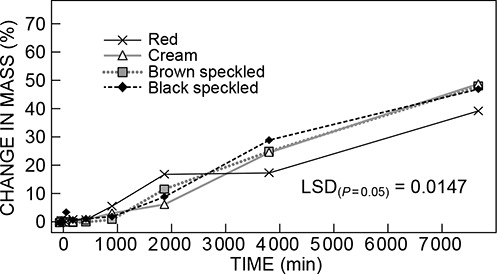
There were highly significant differences (P < 0.001) between the landrace selections, imbibition time and their interaction with respect to water activity (). Water activity was shown to fluctuate. Initial seed water activity for all the landrace selections was c. 0.4 and then increased to c. 0.9 during the first 30 min and then decreased again to c. 0.6. Water activity thereafter continued to fluctuate between 0.6 and 0.9, but fluctuations were more stable at c. 0.9 after 960 min.
Seed imbibition: seed soaking method
Results of the imbibition test using the seed soaking method showed highly significant differences (P < 0.001) between landrace selections, imbibition time and their interaction (). The change in mass when seeds were soaked in distilled water fluctuated between 5% and 70% for duration of the experiment. An initial rapid change in seed mass (12.5%) was observed in the plain red landrace selection within the first hour and then fluctuated between 5% and 50% thereafter. However, at the end of the experiment the lowest change in mass (27%) was observed in the plain red landrace selection and the highest change in seed mass (69.83%) was observed in the black-speckled landrace selection. The plain cream and brown-speckled landrace selections increased in mass by 56% and 47.57%, respectively.
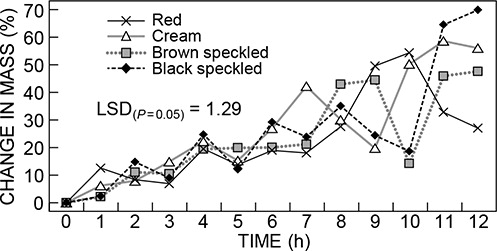
Highly significant differences (P < 0.001) were observed between the landrace selections, imbibition time and their interaction with respect to water activity (). There was a rapid increase in water activity (from c. 0.4 to c. 0.9) within the first hour. Thereafter, the trend was constant, except for the plain cream landrace selection for which water activity decreased from 0.89 to 0.66 between 8 and 9 h before increasing to 0.95 after 10 h ().
Seed coat thickness
Results of seed coat thickness showed significant differences (P < 0.05) across landrace selections (, ). The thickest coat (116.0 µm) was observed in the brown-speckled landrace followed by the plain red landrace selection (111.0 µm) and the thinnest seed coat (107.9 µm) was observed in the plain cream landrace selection (, ).
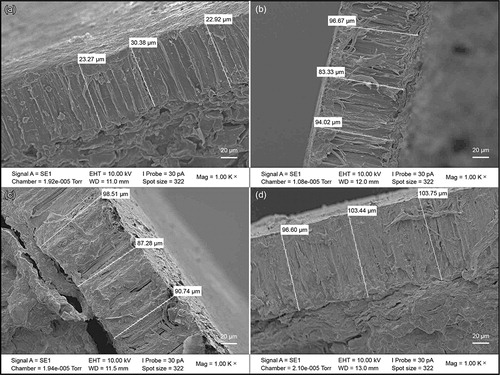
Table 2 Seed coat thickness of bambara groundnut landrace selections (plain red, plain cream, brown speckled and black speckled) viewed and measured under a scanning electron microscope. Numbers in the same column with different letters differ significantly at P = 0.05
Seed mineral composition
The seed coat and cotyledon structure showed different element weight (%) across all landrace selections (). Elements such as carbon, oxygen, magnesium, potassium and calcium were present in all landrace selections and in both seed structures. Phosphorus and sulphur were not observed in the plain red seed coat, whereas iron was observed in the plain red seed coat only. Aluminium was only present in the seed coat of the plain red and brown- speckled landrace selections. Chlorine was not present in both structures of the brown-speckled landrace selection. Three times more calcium was observed in the seed coat structure of the plain cream landrace selection compared to the other landrace selections ().
Table 3 Seed mineral composition (weight; %) of the seed coat and cotyledon of bambara groundnut landrace selections (plain red, plain cream, brown speckled and black speckled) evaluated under a scanning electron microscope using the energy dispersive x-ray spectrometry technique. ND = Not detected
Discussion
The objective of the study was to determine the effect of seed coat and speckling colour on seed quality of a bambara groundnut landrace. Results of the standard germination test showed that the plain cream landrace selection was less viable compared to the other landrace selections. Previous studies (Sinefu Citation2011; Mabhaudhi and Modi Citation2013) that focused on plain bambara groundnut colours reported dark-coloured seeds to perform better compared to light-coloured seeds. This was related to tannins (and specifically polyphenols) present in dark-coloured seeds (Michalak Citation2006; Mabhaudhi and Modi Citation2013). Polyphenols exhibit antioxidant properties and act as a defence mechanism against plant stress and could therefore confer a degree of stress tolerance during germination and emergence. In this case, the black-speckled landrace selection performed better than the other landrace selections, suggesting that speckles could be a useful selection criterion for seed quality in bambara groundnut.
It is interesting to note that results of seed vigour indices (dry mass and EC) were contrary to results of viability. Although the plain cream landrace selection had the lowest germination potential (67%), the dry mass was the highest of all landrace selections. Burris and Black (Citation1976) hypothesised that vigorous seeds were able to synthesise new material and rapidly transfer these new products to the emerging embryonic axis, resulting in higher dry mass. Based on this theory, the plain cream landrace selection could be more vigorous compared to the other landrace selections. The black-speckled landrace selection was more viable and less vigorous based on results of dry mass. The EC was consistent with dry mass in that the plain cream landrace selection had the lowest EC compared with other landrace selections. This finding also suggested that the plain cream landrace selection may be more vigorous than the brown- and black-speckled landrace selections. The results of the current study, with respect to EC, were contrary to the findings by Sinefu (Citation2011), who reported that light-coloured seeds had higher EC than dark-coloured seeds. Sinefu (Citation2011) attributed the high EC to a thin seed coat present in light-coloured seeds.
In the current study, the plain cream landrace selection had the thinnest seed coat. Interestingly, high EC was observed in the brown-speckled landrace selection, which also had the thickest seed coat. Based on these results, it cannot be concluded that there was an association between seed coat thickness and EC as previously alluded to by Sinefu (Citation2011). The inconclusiveness of these results suggests that there may be a need to evaluate other parameters when determining seed quality. Modi (Citation2013) suggested the use of seed mineral content as a rapid physiological seed quality test in bambara groundnut. Calcium in legumes enhances cell wall integrity and reduces rate of water movement (Mazibuko and Modi Citation2005). The high calcium content observed in the plain cream landrace selection could have led to greater cell wall integrity and hence reduced electrolyte leakage.
Imbibition rate was different for the different imbibition methods (seed-testing water bath and seed soaking method). Seeds absorbed more water when soaked in distilled water than when soaked in the seed-testing water bath. This was possibly due to hydration matrices where the degree of contact of the seed with water influences the imbibition rate (Desai Citation2004). Similar behaviour was observed for chickpea and maize, where the rate of water imbibition was higher when seeds were soaked in distilled water than when they were planted in moist soil (Rahman et al. Citation2011). The large fluctuations in change in mass when seeds were soaked could be due to influx of water into the cells of dry seeds, particularly to membranes, which led to an immediate and rapid leakage of solutes and low-molecular-weight metabolites into the imbibition solution (Rahman et al. Citation2011). The argument advanced by Rahman et al. (Citation2011) could also explain the fluctuations in mass observed in the black-speckled landrace selection on the water bath during the early stages of imbibition. Seed coat colour significantly affected imbibition rate. The slow imbibition rate and highest final change in mass observed in the plain cream landrace selection could be due to cell wall integrity and minimal electrolyte leakage. The slow imbibition rate observed for the plain cream landrace selection could explain the low GVI; the rate of water uptake was slow, hence the slow speed of germination.
The measurements of water activity during imbibition intervals were done to determine the amount of water in the seed available for hydration of other substances (Colas et al. Citation2010). The water activity trends for both imbibition methods used in this study were found to be inconsistent. The fluctuations of water activity during imbibition on the seed-testing water bath could have been due to the relatively high proteins content in bambara groundnut seeds (16-24%). Proteins are zwitterions in that they exhibit both negative and positive charges that attract highly charged water molecules (McDonald and Copeland 2001). It can therefore be hypothesised that protein-mediated hydration of the cotyledons was higher than the rate of water uptake by the seed, hence the fluctuations observed in .
Conclusion
This study has revealed that (1) seed coat colour has an effect on seed quality, (2) speckling in bambara groundnut seeds may be associated with seed quality, and (3) seed viability may not necessarily imply good seed vigour. Based on the results of this study, the black-speckled landrace selection of bambara groundnut was more viable and vigorous compared to the brown-speckled landrace selection. Contrary to authors who studied seed quality of other bambara groundnut landraces and found dark-coloured seeds to be more vigorous than light-coloured seeds, this study showed that the plain cream landrace selection was more vigorous than the other three landrace selections based on results of dry mass and electrolyte conductivity. This inconsistent behaviour amongst different landrace selections justifies the need to test seed quality in different bambara groundnut landraces. Results of the current study are useful for immediate seed selection by farmers and long-term crop improvement for the seed industry. Future studies should evaluate the genetics of seed coat colour and its variations, if this characteristic is to be exploited for future crop improvement. The results of seed coat and cotyledon mineralogy and the lack of adequate literature to discuss them suggests that future research should also focus on these characteristics.
Acknowledgements
The Water Research Commission of South Africa is acknowledged for initiating, funding, managing and directing this research through WRC Project no. K5/2274/4 ‘Determining water use of indigenous grain and legume food crops’.
References
- AOSA (Association of Official Seed Analysts). 1980. Seed evaluation handbook. Contribution no. 14. Boise: AOSA.
- Azam-Ali SN, Aguilar-Manjarrez J, Bannayan-Avval M. 2001. A global mapping system for bambara groundnut production. FAO Agricultural Information Management Series 1. Rome: FAO.
- Basra, AS. 1995. Seed quality: basic mechanisms and its implications in agriculture. New York: Harworth Press.
- Basra, AS. 2005. Handbook of seed science and technology. New York: Harworth Press.
- Burris, RH, Black, CC. 1976. CO2 metabolism and plant productivity. London: University Park Press.
- Chimonyo, VGP, Modi, AT. 2013. Seed performance of selected bottle gourd (Lagenaria siceraria (Molina) Standl). American Journal of Experimental Agriculture 3: 740–766.
- Colas F, Baldet P, Bettez M. 2010. Water activity measurement: demonstration of a single and non-specific optimal storage value for orthodox forest seeds. Paper presented at the ISTA 2010 Congress, 16–20 June 2010, Köln, Germany, .
- Copeland OL, McDonald MB (eds). 2001. Principles of seed science and technology. Boston: Kluwer Academic Publishers.
- Desai, BB. 2004. Seeds handbook: biology, production, processing and storage (2nd edn). New York: Marcel Dekker.
- Ellis, RA, Roberts, EH. 1981. The quantification of ageing and survival in orthodox seeds. Seed Science and Technology 9: 373–409.
- Finch-Savage, WE, Leubner-Metzger, G. 2006. Seed dormancy and the control of germination. New Phytologist 171: 501–523.
- Hershey, DR. 2010. Bean seed imbibition. Science Activities: Classroom Projects and Curriculum Ideas 35: 25–27.
- Hillocks, RJ, Bennett, C, Mponda, OM. 2011. Bambara nut: a review of utilization, market potential and crop improvement. African Crop Science Journal 20: 1–16.
- ISTA (International Seed Testing Association). 2012. International rules for seed testing. Zurich: ISTA.
- Legwaila, GM, Karikari, SK, Mogamisi, K, Mathowa, T. 2013. Response of three bambara groundnut landraces to presowing hydration in Botswana. Agriculture and Biology Journal of North America 4: 430–434.
- Liu F. 2004. Physiological regulation of pod set in soybean (Glycine max L. Merr.) during drought at early reproductive stages. PhD Thesis, The Royal Veterinary and Agricultural University, Copenhagen, Denmark.
- Mabhaudhi T. 2009. Responses of landrace maize (Zea mays L.) to water stress compared with commercial hybrids. MSc thesis, University of KwaZulu-Natal, South Africa.
- Mabhaudhi, T, Modi, AT. 2013. Growth, phenological and yield responses of a bambara groundnut (Vigna subterranea (L.) Verdc.) landrace to imposed water stress under field conditions. South African Journal of Plant and Soil 30: 69–79.
- Mabhaudhi, T, Modi, AT, Beletse, YG. 2013. Growth, phenological and yield responses of a bambara groundnut (Vigna subterranea L. Verdc) landrace to imposed water stress: ll. Rain shelter conditions. Water SA 39: 191–198.
- Maguire, JD. 1962. Speed of germination—aid in selection and evaluation for seedling emergence and vigor. Crop Science 2: 176–177.
- Makanda, I, Tongoona, P, Madamba, R, Icishahayo, D, Derera, J. 2009. Evaluation of bambara groundnut varieties for off-season production in Zimbabwe. African Crop Science Journal 16: 175–183.
- Mazibuko, TG, Modi, AT. 2005. Regulation of water absorption by Ca2+ osmolarity alleviates cotyledonal cracking in green beans (Phaseolus vulgaris). Seed Science and Technology 33: 303–313.
- McDonald, MB, Copeland, OL. 1997. Seed production: principles and practices. New York: Chapman and Hall.
- McGill C. 2012. Water activity measurements in seed testing. Paper presented at the ISTA 2012 Congress, 11–14 June 2012, Sydney, Australia. Available at www.seedtest.org/upload/cms/user/ISTA-June11-Seminar-1330-McGill.pdf [accessed 19 May 2014].
- Michalak, A. 2006. Phenolic compounds and their anti-oxidant activity in plants growingunder heavy metal stress. Polish Journal of Environmental Studies 4: 523–530.
- Modi, AT. 2013. Pregermination hydration affects seed performance in bambara groundnut. Scientific Research and Essays 8: 940–945.
- Nonogaki, H, Bassel, GW, Bewley, JD. 2010. Germination—still a mystery. Plant Science 179: 574–581.
- Ntombela Z. 2013. Growth and yield responses of cowpeas (Vigna unguiculata L.) to water stress and defoliation. MSc thesis, University of KwaZulu-Natal, Pietermaritzburg, South Africa.
- Ogbuehi HC, Madukwe DK, Ashilonu P. 2013. Assessment of hydro priming of seeds on performance of morphological indices of bambara groundnut (Vigna subterrenea [sic] Linn.) landrace. Global Journal of Biology, Agriculture and Health Sciences 2(2): 17–22.
- Rahman, MM, Ahammad, KU, Alam, MM. 2011. Effect of soaking conditions and temperature on imbibition rate of maize and chickpea seeds. Journal of Seed Science 4: 117–124.
- Sesay, A. 2009. Influence of flooding on bambara groundnut (Vigna subterranea L.) germination: effect of temperature, duration and timing. African Journal of Agricultural Research 4: 100–106.
- Sinefu F. 2011. Bambara groundnut response to controlled environment and planting date associated water stress. MSc thesis, University of KwaZulu-Natal, Pietermaritzburg, South Africa.
- Tekrony DM, Egli D. 1991. Relation of seed vigour to crop yield: a review. Crop Science 31: 816–822.
- Zondi LZ. 2013. Responses of bambara groundnut (Vigna subterranea L. Verdc) landraces to field and controlled environment conditions of water stress. MSc thesis, University of KwaZulu-Natal, Pietermaritzburg, South Africa.

